Phage display for engineering blood-contacting surfaces

Surfaces that enable endothelial cell attachment without causing blood clotting are needed for various tissue engineering efforts. A new approach involving phage display has been used to identify unique peptides with these typically divergent characteristics. The work is published in Tissue Engineering.
Maria Chiara Munisso, Ph.D., and Tetsuji Yamaoka, Ph.D., both at the National Cerebral and Cardiovascular Center Research Institute, Osaka, Japan, present their work in an article titled "Evolution of Phage Display Approaches to Select Highly Specific Hemocompatible Peptides." The authors developed a high-throughput phage display selection protocol to identify peptides with high affinity for endothelial cells using both positive selection and an extra negative selection against platelet-binding sequences, and a phage binding index was used to compare affinities to those of naked M13 phage. After modification with candidate peptides, an expanded polytetrafluoroethylene surface was tested for endothelial progenitor cell binding and clotting induction, and a sequence with desirable dual characteristics was validated.
"The use of Negative-Positive bio-panning with the techniques proposed by the authors demonstrates a clear improvement in strategies to identify peptides for biofunctionalization," says Tissue Engineering Co-Editor-in-Chief Antonios G. Mikos, Ph.D., Louis Calder Professor at Rice University, Houston, TX. "This can dramatically improve the search for new biofunctional peptides which can be used across all facets of tissue engineering and medical devices."
More information: Maria Chiara Munisso et al, Evolution of Phage Display Approaches to Select Highly Specific Hemocompatible Peptides, Tissue Engineering Part C: Methods (2019). DOI: 10.1089/ten.tec.2018.0367
Provided by Mary Ann Liebert, Inc





















